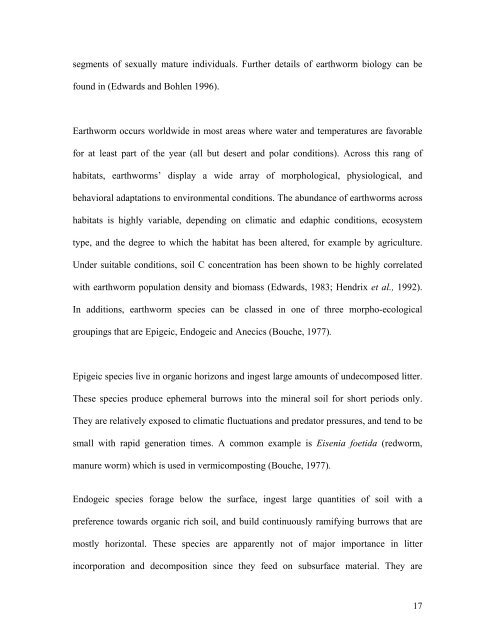Mekelle University The School of Graduate Studies Faculty of ...
Mekelle University The School of Graduate Studies Faculty of ...
Mekelle University The School of Graduate Studies Faculty of ...
- No tags were found...
Create successful ePaper yourself
Turn your PDF publications into a flip-book with our unique Google optimized e-Paper software.
segments <strong>of</strong> sexually mature individuals. Further details <strong>of</strong> earthworm biology can befound in (Edwards and Bohlen 1996).Earthworm occurs worldwide in most areas where water and temperatures are favorablefor at least part <strong>of</strong> the year (all but desert and polar conditions). Across this rang <strong>of</strong>habitats, earthworms’ display a wide array <strong>of</strong> morphological, physiological, andbehavioral adaptations to environmental conditions. <strong>The</strong> abundance <strong>of</strong> earthworms acrosshabitats is highly variable, depending on climatic and edaphic conditions, ecosystemtype, and the degree to which the habitat has been altered, for example by agriculture.Under suitable conditions, soil C concentration has been shown to be highly correlatedwith earthworm population density and biomass (Edwards, 1983; Hendrix et al., 1992).In additions, earthworm species can be classed in one <strong>of</strong> three morpho-ecologicalgroupings that are Epigeic, Endogeic and Anecics (Bouche, 1977).Epigeic species live in organic horizons and ingest large amounts <strong>of</strong> undecomposed litter.<strong>The</strong>se species produce ephemeral burrows into the mineral soil for short periods only.<strong>The</strong>y are relatively exposed to climatic fluctuations and predator pressures, and tend to besmall with rapid generation times. A common example is Eisenia foetida (redworm,manure worm) which is used in vermicomposting (Bouche, 1977).Endogeic species forage below the surface, ingest large quantities <strong>of</strong> soil with apreference towards organic rich soil, and build continuously ramifying burrows that aremostly horizontal. <strong>The</strong>se species are apparently not <strong>of</strong> major importance in litterincorporation and decomposition since they feed on subsurface material. <strong>The</strong>y are17
















